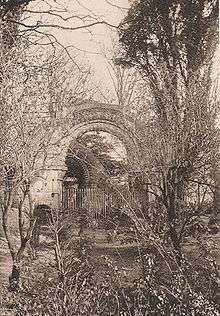Whitekirk and Tyninghame
| Whitekirk Tyninghame |
|
 Whitekirk Tyninghame |
|
| OS grid reference | NT610791 |
|---|---|
| Council area | East Lothian |
| Lieutenancy area | East Lothian |
| Country | Scotland |
| Sovereign state | United Kingdom |
| Post town | Dunbar |
| Postcode district | EH42 |
| Dialling code | 01620 870xxx |
| Police | Scottish |
| Fire | Scottish |
| Ambulance | Scottish |
| EU Parliament | Scotland |
| UK Parliament | East Lothian |
| Scottish Parliament | East Lothian |
Coordinates: 56°01′33″N 2°38′55″W / 56.0257°N 2.6486°W
Tyninghame and Whitekirk is a civil parish, centred on two small settlements in East Lothian, Scotland.
Whitekirk
Whitekirk is 4 mi (6.4 km) from North Berwick, 8 mi (13 km) from Dunbar and 25 mi (40 km) east of Edinburgh. A place of Christian worship from the earliest times and known in Old English: Hwīt Cirice, having a holy well, now lost, dedicated to St Mary the Virgin, and a famous statue, likewise dedicated and known as Our Lady of Haddington. It was on the pilgrim's route from St Andrews to Santiago de Compostela and described as a stopping point in the Iter pro peregrinis ad Compostellam., Book V of the Codex Calixtinus.

The shrine of Our Lady at Whitekirk was desecrated by the armies of Edward III of England in 1356, a period that would become known as the Burnt Candlemas. Later in the 14th century, the shrine of our lady was reconsecrated at the newly built Church of St. Mary the Virgin in Haddington. Whitekirk continued to be a place of pilgrimage, however, receiving visits from the future Pope Pius II and Kings James IV and James V.
In early 1435, Aeneas Piccolomini (Pope Pius II) was travelling to Scotland on a diplomatic mission as Papal legate, when his ship was beset by storms. After giving prayers to Our Lady, the ship and its crew made port safely at Dunbar, and having promised to walk barefoot to the nearest shrine to the virgin, Piccolomini set out for Whitekirk. The eight miles through the frozen countryside left him with rheumatism that he would complain about for the rest of his life.
The Covenanting preacher John Blackadder gave his last conventicle on the hill behind the Church in 1678.
The Holy Well dried up in the 19th century following agricultural drainage, but is thought to be located not far from the church building.
The current Church was last restored in 2005-6. Dramatic events in 1914 saw the Church set on fire, allegedly by Suffragette campaigners, although this has not been proven. The Kirk was restored by the office of Sir Robert Lorimer.
Whitekirk derives its name from the original colour of the Kirk: White, and was once known as 'Hamer' or the greater Ham. The Church is now the red of its underlying sandstone.
Whitekirk Pilgrimage
On the 2nd Saturday of May, every year since 1971, there is an ecumenical pilgrimage that starts at Whitekirk and finishes in Haddington. Originally started by the Patrick Maitland the 17th Earl of Lauderdale, the numbers attending rose from 30 people in the early seventies to over 2000; however, in 2008 the pilgrimage was cancelled due to lack of numbers.
Tyninghame

Tyninghame is an ancient parish that was joined to Whitekirk in 1761. The name is Northumbrian Old English: Tinangehām, and means Hamlet on the Tyne. The original church at Tyninghame was founded by Saint Baldred[1] an Anchorite described as the "Apostle of the Lothians". In 941 AD, the church and village of Tyninghame was destroyed by Anlaf the Dane.
The oldest extant records give the superiors of the lands of Tyninghame as the Archdiocese of Saint Andrews, doubtless because of its connexions with Saint Baldred. From at least the end of the 11th century the lands were occupied by the Lauder of The Bass family, and in 1628 passed to the Earl of Haddington. In June 1617 the Lauders are recorded as being the patrons of the church there, and the Session Book records that they provided for the new sacramental vessels for communion that year: "Suma of money to be payit be the Ladie Bass, six scor pundis, ane pund, five s." Relations between The Church and the local patrons were not always good and it is recorded on 4 February 1621, that a fine was paid: "Given be the Ladie Bass for penaltie of her servand quha brak ye Sabbothe, 18s".[2]
In 1761 the Earl of Haddington moved Tyninghame village from its original position, to the west of the policies of Tyninghame House to make way for landscaped parkland.
Tyninghame House

Tyninghame House, a category A listed building, is located to the east of the village by the estuary of the River Tyne. It lies adjacent to the site of the original village, and within the gardens can be seen the remains of St. Baldred's church. There was a manor at Tyninghame in 1094, and it was later a property of the Lauder of The Bass family. In the 17th century it was sold to the Earl of Haddington. The present building dates from 1829 when the 9th Earl of Haddington employed William Burn to greatly enlarge the house in the Baronial style. In 1987 the contents of the house were sold, and the house was divided into flats.
References
Notes
Sources
F. H. Groome, Ordnance Gazetteer of Scotland. Edinburgh 1883